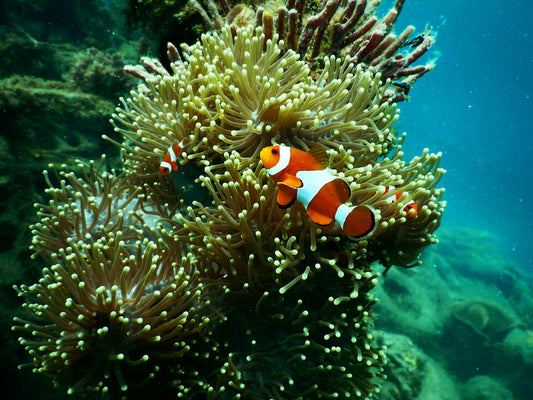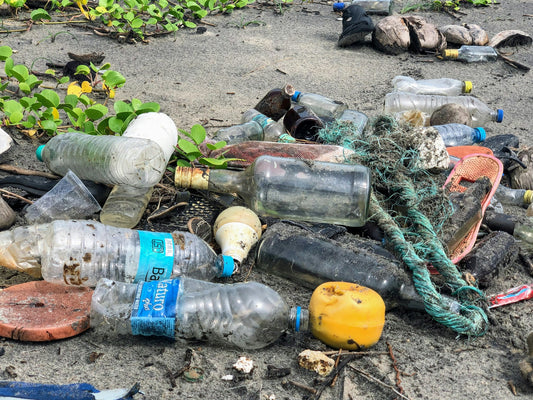Share
Plastic took the world by storm
Plastic has become an integral part of our lives. It is part of almost everything we do, from food packaging to technology to medical equipment. It is hard to imagine a single day without this material.
The "success story" of plastic is even more fascinating given its production only scaled up in the mid-20th century.
In the last seven decades, plastic production has exploded from 1.5 million tons in 1950 to more than 400 million tons in 2023.
That's the weight of 1100 Empire State Buildings or 2 million blue whales! Every single year!
And there is no end in sight. The production is on a trajectory to triple again until 2060 to more than 1200 million tons.
Unfortunately, as our reliance on plastic grows, so do the the devastating environmental impacts.
Based on the relentlessly growing plastic production, and increasing pollution levels, researchers estimate that by 2050 there will be more plastic in the sea than fish.
In this article, we'll explore the complex relationship between plastics and us humans, weighing its undeniable advantages with detrimental environmental impacts. Finally, we'll discuss a potential path to a future with less plastic pollution.
The advantages of plastic are undeniable
There are very good reasons for the incredible success of plastic that go back to its invention.
In 1907 a guy named Leo Hendrik Baekeland was celebrated by many for his invention of Bakelite, the first fully synthetic plastic.
Bakelite was not only a good insulator, but it was also
- more durable
- more heat resistant
- cheaper to produce
- better suited for mechanical mass production
than other materials known to the world at this time.
Bakelite was deemed "the material of a thousand uses", and its invention led major investments in the research and development of new plastics.
The material was revolutionary and opened up a whole new world of opportunities for manufacturing across all industries.
It is not exaggerated to state that plastic, due to its great material qualities, has improved our quality of life and fueled innovation in many ways.
- Food security: plastic helped to extend the shelf life of products and increased food security for many countries in need, which also reduces food waste.
- Medicine: plastic is used in many products for the medical industry and significantly improved sterility, saving many lives.
- Safety equipment: Since world war 2, plastic has been playing an important role for safety equipment like protective gear, ropes, garments, and a lot more.
- Energy efficiency: plastic-based insulation helps us seal our homes from the cold and thus create more energy-efficient homes.
- Transportation: Plastic helped reduce the weight and increase the efficiency of cars, trucks, and trains, which saves valuable resources.
- Environmental protection: Ironically, plastic was invented to protect scarce natural resources and it replaced things like ivory, turtle shell, and wood for many products.
The environmental impacts are devastating
There's no denying the advantages that plastic brings to our modern world. Its material properties have allowed major innovation from food security to medical equipment.
During the time of its invention, plastic has even helped protect the environment by reducing usage of natural materials. This helped reduce logging and advanced the protection of elephants, rhinos, and other animals.
However, the optimism about plastic didn't last long and already in the 1960s society got increasingly aware of the environmental problems caused by plastic pollution.
Partly due to various marketing efforts from the plastic industry - the glorification of recycling being one of them - global plastic production only experienced a small bump in the road, before continuing its upward trajectory.
Given the extensive use of plastic, previously celebrated advantages are now overshadowed by devastating environmental impacts.
If you know our blog, you're familiar with the environmental impact behind plastic bottles, bags, straws, and other plastic products.
- The extensive plastic production consumes crude oil and energy, contributing to global warming significantly
- More and more of the billions of plastic products consumed every year leak into the environment, where they take hundreds of years to degrade
- Hundreds of thousands of marine animals are killed every year by ocean plastic
- Microplastic is everywhere and has even found its way into the human body through the food chain
If we'd continue to list all negative effects behind plastic usage and plastic pollution, you would never be able to finish reading this article.
Plastic pollution has become one of the major global crises with environmental, social, and economic impacts.
So how do we find the right balance between the advantages of plastic as a material and its impacts on pollution?
To answer this question, we nee to take a step back and ask ourselves: "Where do we really NEED plastic"?
Finding the right path to a future without plastic pollution
Due to its material properties, it will likely be hard to completely replace plastic in the near future for some of its applications.
This likely includes mainly applications in the medical industry, where plastic has proven essential for safety and hygiene.
Another example are exceptions in the food industry. While the majority of food packaging could easily be replaced by glass, aluminum, or paper (bring back the milk jar!), there may be very specific examples where plastic is required for food safety (e.g. for meat packaging or in humanitarian aid).
BUT: only if plastic is truly essential and can only be replaced with alternative materials at a significant disadvantage, plastic should be considered as the go-to material.
AND: Only because plastic seems like the right choice, we should not default to single-use plastic.
The key to a sustainable future without plastic pollution is a collaborative effort where governments, businesses, and consumers work together to build a circular economy that significantly Reduces the need for plastic production.
"The circular economy is a system where materials never become waste and nature is regenerated. In a circular economy, products and materials are kept in circulation[..]"

Governments
Government bodies on the global, regional, and local level need to develop a holistic strategy that involves all market players around businesses and consumers and sets the foundation for long-term change.
The United Nations Environment Assembly (UNEA) has made major progress on the global level by defining the United Nations' Plastic Pollution Resolution. The assembly agreed on reaching a final binding strategy in 2024, which sets the baseline and defines guardrails that regional and local governments need to implement.
The document includes many measures including
- strengthening the science-policy interaction and understanding the impact of pollution
- promoting sustainable product and material Redesign that enables Reusability, Repurposing, and Recycling of end products
- support for initiatives that Recover marine litter and microplastic
- creation of an internationally binding instrument to address pollution
- reporting on progress of measures
While this is a great first step, it is essential that regional and local governments adopt specific policies that turn these generic measures into action.
Examples for regional and local adoption are manyfold but they can include:
- the implementation of plastic bans,
- the introducing return deposit schemes,
- funding scientific research
- offering monetary incentives for sustainable production
- launching public awareness campaigns
Unfortunately, we need to expect that the mills of politics grind slowly.
Businesses
Businesses should not wait for regulations and see sustainability as a chance for innovation.
Those investments help can finally lead to a competitive advantage for innovative businesses and first movers.
Just take Patagonia as an example. By considering sustainability in their whole supply chain, from raw materials to repurchasing and distributing used clothes, Patagonia has grown into one of the most successful fashion brands globally. They
- Reject virgin synthetic fibers in their clothing and Reduce their raw material usage
- Recover used clothes directly from customers for Recycling or Reuse in their worn wear online store
- Have a comprehensive Repair program for clothes
By implementing this holistic sustainability strategy, they not only attract environmentally conscious customers and employees, but also yield improvements in operational efficiency and cost reduction.
Individuals
Finally, every individual contributes to the success of a sustainable circular economy.
While you may think your actions as an individual are only a drop in the bucket, this could not be further from the truth.
Our daily habits and actions have a significant impact on the waste we produce every year as a society, and they are a signal for businesses to change their practices.
A simple example: What would happen, if we all Rejected buying coffee in single-use cups?
I am always amazed when we go for a coffee and the line in the drive through has 20 cars waiting for their takeout coffee.
We then go inside, fill our Reusable cup, save 10 cents per coffee and are outside again within 5 minutes. In the meantime, cars are still waiting for their coffee in a single-use cup that'll go lukewarm in 10 minutes.
In North America, we consume more than 130 billion single-use coffee cups every year. Just imagine the impact if only a few percent of consumers changed their habits.
The same pattern holds true for many more single use items like straws, plastic bottles, or plastic bags. You as a consumer have the power to make small changes in your life that add up to a big impact.
Every individual can help create a more sustainable future implementing small changes into their daily lives.
- Reduce your consumption and ask yourself "Do I really need this"
- Reject single use plastics and opt for sustainable alternatives. You'll be amazed how many great products are available for your bathroom, kitchen, and all areas of your life
- Reuse, Repair, and Repurpose what you already have
- Educate yourself about how to separate waste to allow for Recovery, Rotting, and Recycling
We all created a plastic world, we all need to change it
Plastics have become a ubiquitous part of our daily lives, where they offer undeniable advantages, while damaging the environment at a detrimental rate.
The future trajectory of plastic production, which already surpasses 400 million tons annually is predicting a dark future for all of us.
However, there is still hope to turn the wheel and embrace a more sustainable world for generations to come.
If governments, businesses, and individuals all integrate sustainable choices into everything they do, we can hope for a future with less pollution.
In this shared effort, every action counts and even the smallest changes in daily habits can have ripple effects that pave the way for substantial impact.
We hope you enjoyed this article. If you want to read more like this, make sure to check out our Blog and follow us on Instagram. If you are interested in truly sustainable products, check out our Shop.
If you want to engage in the discussion, feel free to leave a comment below.











